Managing yur Golden Retriever’s weight doesn’t mean sacrificing nutrition or flavor. The right low calorie dog food can transform your furry friend’s health while maintaining their energy and happiness. Golden Retrievers are particularly prone to weight gain due to their love of food and genetic predisposition to slower metabolism, making the selection of appropriate low-calorie nutrition crucial for their long-term wellbeing.
This comprehensive guide explores everything Golden Retriever owners need to know about low calorie dog food, from understanding caloric density to selecting the perfect formula for your dog’s unique needs. Whether your Golden Retriever needs to lose significant weight or maintain their current healthy size, the right low-calorie nutrition can make all the difference.
Contents
- 1 Understanding Caloric Density in Dog Food
- 2 Nutritional Balance in Low Calorie Formulations
- 3 Brand Analysis: Leading Low Calorie Dog Food Options
- 4 Transitioning to Low Calorie Dog Food
- 5 Portion Control Strategies with Low Calorie Dog Food
- 6 Enhancing Low Calorie Dog Food Effectiveness
- 7 Monitoring and Adjusting Low Calorie Dog Food Plans
- 8 Addressing Common Challenges
- 9 Long-term Success with Low Calorie Dog Food
- 9.1 Maintenance Phase Transition
- 9.2 Lifestyle Integration
- 9.3 What exactly makes dog food low calorie and safe for Golden Retrievers?
- 9.4 How many calories should my overweight Golden Retriever consume daily with low-calorie dog food?
- 9.5 Can I mix low calorie dog food with regular dog food?
- 9.6 Which brands offer the most effective low calorie dog food for Golden Retrievers?
- 9.7 How long does it take to see results with low calorie dog food?
- 9.8 Is low calorie dog food nutritionally complete for Golden Retrievers?
- 9.9 Can puppies or senior Golden Retrievers eat low calorie dog food?
- 9.10 What should I do if my Golden Retriever is still hungry after eating low-calorie dog food?
- 9.11 How do I calculate the right portion size for low-calorie dog food?
- 9.12 Can I give treats while feeding low calorie dog food?
- 10 Final Thoughts
Understanding Caloric Density in Dog Food
Low-calorie dog food isn’t simply about reducing portion sizes– it’s about maximizing nutritional value while minimizing calories per cup. Golden Retrievers require approximately 1,200-1,800 calories per day, depending on their size, age, and activity level, but overweight dogs may need 20-30% fewer calories to achieve healthy weight loss.
The concept of caloric density becomes crucial when selecting best dog food for Golden Retrievers. Premium formulations typically contain 300-350 calories per cup compared to regular adult formulas that may contain 400-450 calories per cup. This reduction allows your Golden Retriever to maintain satisfying portion sizes while consuming fewer overall calories.
Metabolizable Energy Calculations
Low-calorie dog food manufacturers use metabolizable energy (ME) calculations to determine the actual calories your Golden Retriever’s body can use from each serving. This system accounts for digestibility and nutrient absorption, providing more accurate caloric information than simple analysis.
Understanding ME values helps Golden Retriever owners make informed decisions about low calorie dog food selection. Foods with higher digestibility provide more usable energy per calorie, allowing for smaller portions while maintaining satisfaction and nutrition.
Calorie Distribution Throughout the Day
Effective use of low-calorie dog food involves strategic calorie distribution to maintain your Golden Retriever’s energy levels and prevent hunger-driven behaviors. Dividing daily calories across three smaller meals helps stabilize blood sugar and reduces the likelihood of overeating.
Morning meals should contain approximately 40% of daily calories when using low calorie dog food, as Golden Retrievers tend to be most active during daylight hours. Evening portions can be smaller, accounting for reduced nighttime activity levels.
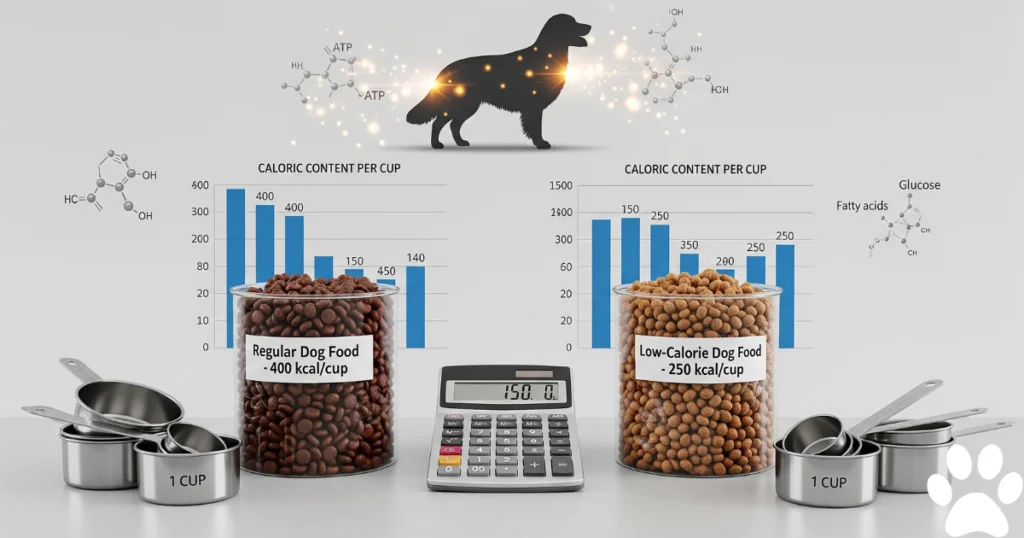
Nutritional Balance in Low Calorie Formulations
The challenge with low calorie dog food lies in maintaining complete nutrition while reducing calories. Premium formulations achieve this through nutrient-dense ingredients that pack essential vitamins, minerals, and macronutrients into fewer calories per serving.
Quality low calorie dog food for Golden Retrievers should contain 25-30% protein to support muscle maintenance during weight management. This higher protein percentage (compared to regular adult food at 18-25%) helps preserve lean muscle mass while the body burns stored fat for energy.
Protein Quality and Amino Acid Profiles
Low calorie dog food relies heavily on high-quality protein sources to provide essential amino acids without excess calories. Named meat sources like deboned chicken, turkey, or salmon should appear as the first ingredient, indicating protein quality and digestibility.
Complete amino acid profiles in low calorie dog food support your Golden Retriever’s muscle maintenance, immune function, and coat health during weight management. Incomplete proteins can lead to muscle loss and nutritional deficiencies, undermining weight management efforts.
Fat Content Optimization
Strategic fat reduction is essential in low calorie dog food, typically ranging from 8-12% compared to 15-18% in regular adult formulas. However, essential fatty acids must be preserved to support your Golden Retriever’s skin, coat, and cognitive function.
Omega-3 fatty acids from fish oil or flaxseed in low-calorie dog food provide anti-inflammatory benefits, particularly important for overweight Golden Retrievers. These compounds support joint health while the body adjusts to increased activity levels during weight management.
Carbohydrate Selection and Fiber Integration
Low calorie dog food utilizes complex carbohydrates and fiber sources to provide energy while promoting satiety. Sweet potatoes, peas, and brown rice offer sustained energy release without rapid blood sugar spikes that can trigger hunger.
Fiber content in quality low calorie dog food typically ranges from 5-8%, higher than regular adult formulas. This increased fiber helps your Golden Retriever feel full between meals while supporting healthy digestion and nutrient absorption.
Brand Analysis: Leading Low Calorie Dog Food Options
Hill’s Science Diet Perfect Weight
Hill’s Science Diet Perfect Weight consistently ranks among the most effective low-calorie dog food options for Golden Retrievers. This formula contains 291 calories per cup, significantly lower than their regular adult formula, while maintaining complete nutrition through carefully selected ingredients.
The formula incorporates Hill’s proprietary fiber blend that helps Golden Retrievers feel satisfied with smaller portions. Clinical studies show dogs maintain their weight loss for up to one year after reaching target weight while continuing on this low calorie dog food.
Hill’s includes L-carnitine to support fat metabolism and natural ingredients like chicken and vegetables for palatability. The formula’s antioxidant blend supports immune health during the stress of dietary changes and increased exercise.
Royal Canin Light Weight Care
Royal Canin’s approach to low calorie dog food emphasizes breed-specific nutrition science. Their Light Weight Care formula contains 306 calories per cup and is specifically formulated considering Golden Retriever metabolism and dietary preferences.
The formula features a unique kibble shape designed for the Golden Retriever’s jaw structure, encouraging proper chewing and slower eating. This design feature helps maximize satisfaction from each meal while supporting dental health through mechanical cleaning action.
Royal Canin incorporates EPA and DHA from fish oil in their low calorie dog food to support coat health and reduce inflammation. The formula also includes precise mineral ratios to support urinary health, addressing a common concern in Golden Retrievers.
Wellness CORE Reduced Fat
Wellness CORE Reduced Fat offers a grain-free approach to low calorie dog food with 338 calories per cup. This formula focuses on high protein content (33%) to support muscle maintenance while reducing fat to 10% for effective calorie control.
The formula includes deboned turkey and chicken as primary protein sources, providing complete amino acid profiles essential for Golden Retriever health. Wellness incorporates probiotics and prebiotics to support digestive health during dietary transitions.
Wellness CORE’s low calorie dog food includes glucosamine and chondroitin for joint support, particularly beneficial for overweight Golden Retrievers experiencing increased joint stress. The formula’s antioxidant blend supports immune function and overall health.
Purina Pro Plan Focus Weight Management
Purina Pro Plan Focus Weight Management provides low calorie dog food with 354 calories per cup while maintaining high palatability that appeals to Golden Retrievers’ food preferences. The formula contains 30% protein to support lean muscle maintenance.
The brand’s OPTIMETABOLISM formula includes increased protein and L-carnitine, specifically designed to support fat burning while preserving muscle mass. Clinical research shows improved weight loss results compared to competitor formulas.
Purina incorporates prebiotic fiber in its low-calorie dog food to support digestive health and nutrient absorption. The formula includes real chicken as the first ingredient, ensuring high-quality protein that Golden Retrievers find appealing.
Blue Buffalo Life Protection Healthy Weight
Blue Buffalo’s natural approach to low calorie dog food features 339 calories per cup with deboned chicken as the first ingredient. Their formula avoids by-product meals, corn, wheat, and soy while maintaining complete nutrition.
The inclusion of LifeSource Bits provides a precise blend of antioxidants, vitamins, and minerals selected by holistic veterinarians. This unique feature in their low calorie dog food supports immune health and overall vitality during weight management.
Blue Buffalo incorporates natural sources of glucosamine and chondroitin in their low calorie dog food to support joint health. The formula includes sweet potatoes and carrots for natural sources of vitamins and fiber.
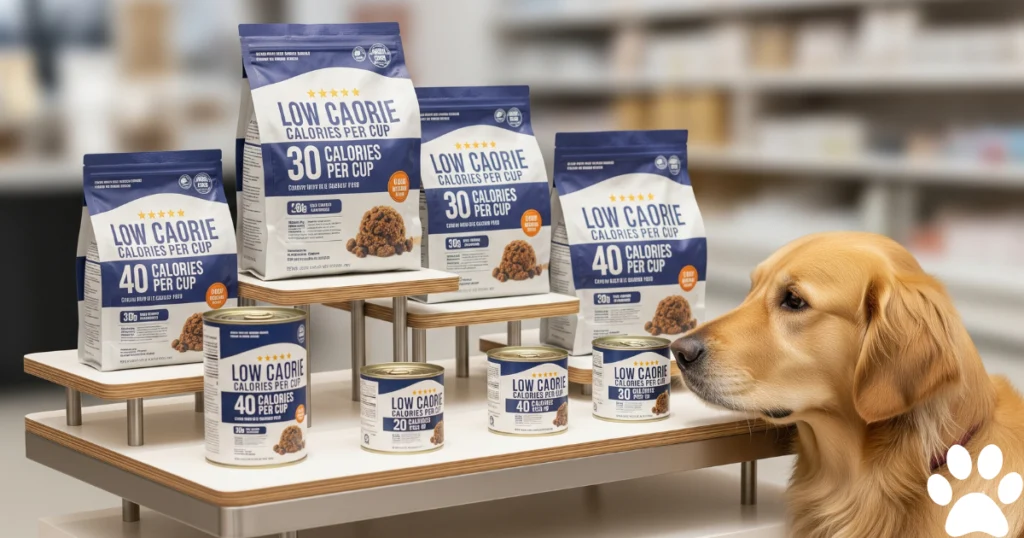
Transitioning to Low Calorie Dog Food
Gradual Introduction Protocols
Successful transition to low calorie dog food requires gradual introduction over 7-10 days to prevent digestive upset common in Golden Retrievers. Begin by mixing 25% new low-calorie formula with 75% current food for the first 2-3 days.
Progressive introduction of low calorie dog food allows your Golden Retriever’s digestive system to adapt to new protein sources and fiber levels. Sudden dietary changes can cause diarrhea, vomiting, or appetite loss that interferes with weight management goals.
Monitor your Golden Retriever’s response during transition to low-calorie dog food, watching for changes in stool consistency, appetite, and energy levels. Most dogs complete the transition successfully, but individual sensitivities may require slower introduction schedules.
Palatability Considerations
Golden Retrievers can be particular about food textures and flavors, making palatability crucial when introducing low-calorie dog food. Some dogs initially resist lower-calorie formulations due to reduced fat content that typically enhances flavor.
Enhance the palatability of low-calorie dog food by warming it slightly or adding small amounts of low-sodium broth. Avoid high-calorie additions that undermine the caloric reduction benefits of specialized formulations.
Patience during the palatability adjustment phase is essential when introducing low calorie dog food. Most Golden Retrievers adapt within 3-5 days, but some may require up to two weeks to fully accept new flavors and textures.
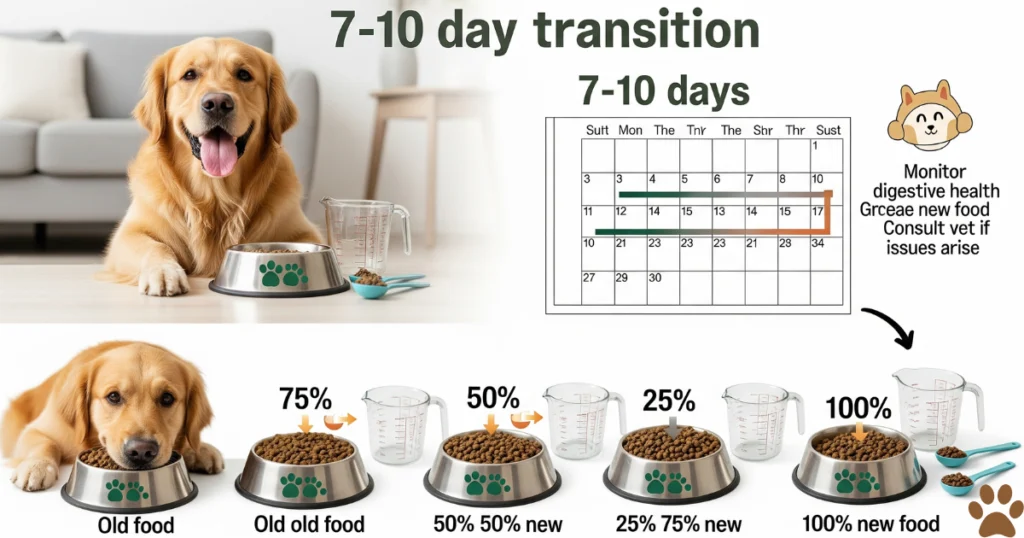
Portion Control Strategies with Low Calorie Dog Food
Accurate Measurement Techniques
Even low calorie dog food requires precise portion control to achieve desired weight management results. Use digital kitchen scales to measure portions by weight rather than volume, as kibble density variations can significantly impact actual calorie intake.
Calculate your Golden Retriever’s daily portions based on their target weight, not current weight, when using low calorie dog food. This approach creates the necessary caloric deficit for weight loss while providing adequate nutrition for their goal size.
Standard measuring cups can be inaccurate for low calorie dog food portioning due to variations in kibble size and shape. Weight-based measurements ensure consistent calorie delivery regardless of formula changes or kibble manufacturing variations.
Meal Frequency Optimization
Divide daily low calorie dog food portions into three meals rather than two to help stabilize your Golden Retriever’s blood sugar and reduce hunger between feedings. This approach maximizes satisfaction while supporting steady metabolism throughout the day.
Morning portions should be the largest when using low-calorie dog food, as Golden Retrievers typically have higher energy needs during active daytime hours. Smaller evening meals prevent excess calories from being stored as fat during lower-activity periods.
Consistent meal timing with low calorie dog food helps establish routine and reduces anxiety-related eating behaviors common in Golden Retrievers. Regular schedules support healthy digestion and improve overall weight management success.
Environmental Feeding Modifications
Slow-feed bowls can enhance the effectiveness of low-calorie dog food by encouraging thorough chewing and slower consumption. These modifications help your Golden Retriever feel more satisfied with smaller portions by extending meal duration.
Puzzle feeders and interactive toys can make low calorie dog food more engaging while providing mental stimulation that reduces boredom eating. These tools are particularly beneficial for Golden Retrievers who tend to eat quickly.
Separate feeding areas in multi-pet households ensure each Golden Retriever receives their prescribed low calorie dog food portions without competition or food stealing that can undermine weight management efforts.
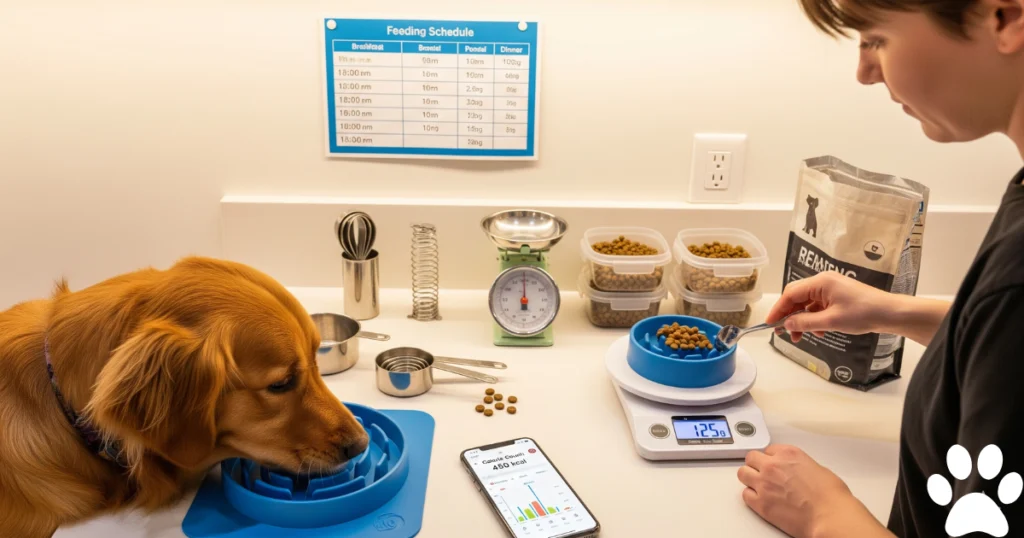
Enhancing Low Calorie Dog Food Effectiveness
Exercise Integration
Low calorie dog food works most effectively when combined with appropriate exercise routines tailored to your Golden Retriever’s current fitness level. Start with low-impact activities like walking and gradually increase intensity as weight decreases.
Swimming is particularly beneficial for overweight Golden Retrievers using low-calorie dog food, as it provides excellent cardiovascular exercise without joint stress. This breed’s natural affinity for water makes swimming an enjoyable complement to dietary management.
Structured play sessions can supplement the calorie-burning effects of low calorie dog food while providing mental stimulation. Games like fetch and hide-and-seek increase activity levels without feeling like formal exercise for your Golden Retriever.
Supplementation Considerations
Most low calorie dog food formulations provide complete nutrition, but some Golden Retrievers may benefit from specific supplements during weight management. Omega-3 fatty acids can support coat health and reduce inflammation associated with increased activity.
Probiotics may enhance the effectiveness of low calorie dog food by supporting digestive health and nutrient absorption. A healthy gut microbiome can improve metabolism and overall response to dietary changes.
Joint supplements containing glucosamine and chondroitin can support overweight Golden Retrievers transitioning to increased activity levels while using low calorie dog food. These supplements help protect joints during the weight loss process.
Hydration Support
Proper hydration enhances the effectiveness of low-calorie dog food by supporting metabolism and helping your Golden Retriever feel full between meals. Ensure fresh water is always available, especially during increased activity periods.
Some Golden Retrievers benefit from wet versions of low-calorie dog food or adding small amounts of warm water to dry kibble. Increased moisture content can enhance satiety while providing the same caloric benefits.
Monitor your Golden Retriever’s water intake when transitioning to low-calorie dog food, as some dogs may drink less with reduced food portions. Adequate hydration is crucial for kidney function and overall health during weight management.
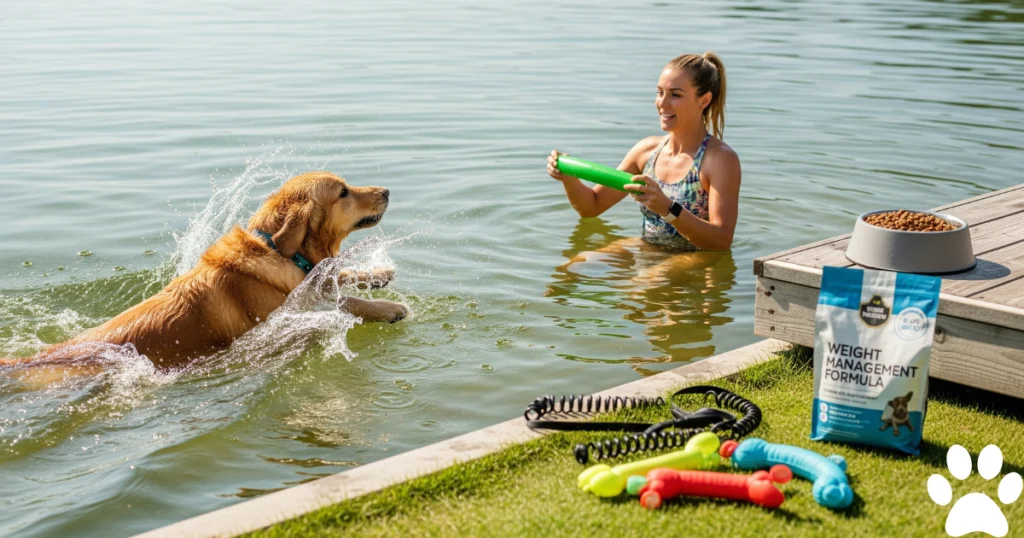
Monitoring and Adjusting Low Calorie Dog Food Plans
Progress Tracking Methods
Regular weight monitoring is essential when using low calorie dog food to ensure safe and effective weight loss. Weigh your Golden Retriever weekly at the same time of day, preferably in the morning before meals.
Body condition scoring complements weight tracking when using low calorie dog food. Learn to assess your Golden Retriever’s body condition by feeling for rib coverage and observing waist definition from above and from the side.
Keep detailed records of weight changes, portion sizes, and any modifications to the low calorie dog food routine. This data helps identify what works best for your individual Golden Retriever and guides future adjustments.
Adjustment Protocols
Weight loss should occur at 1-2% of current body weight per week when using low calorie dog food appropriately. Faster weight loss may indicate portions are too small, while slower progress might require portion reductions or increased activity.
Plateau periods are common during extended use of low calorie dog food. When progress stalls, evaluate treat intake, exercise levels, and adherence to portion guidelines before reducing food quantities further.
Some Golden Retrievers may need formula adjustments within the low calorie dog food category as their weight decreases. Different activity levels or metabolic changes may require switching to formulas with different caloric densities.
Veterinary Collaboration
Regular veterinary check-ups are crucial when using low calorie dog food for significant weight reduction. Your veterinarian can monitor overall health, assess progress, and identify any complications early in the process.
Blood work every 3-6 months helps ensure low calorie dog food diets aren’t negatively affecting organ function. Some Golden Retrievers may need monitoring for changes in liver enzymes or kidney function during weight loss.
Collaborate with your veterinarian to establish realistic timelines and goals when implementing low calorie dog food programs. Professional guidance helps ensure safe, sustainable weight management for your Golden Retriever.
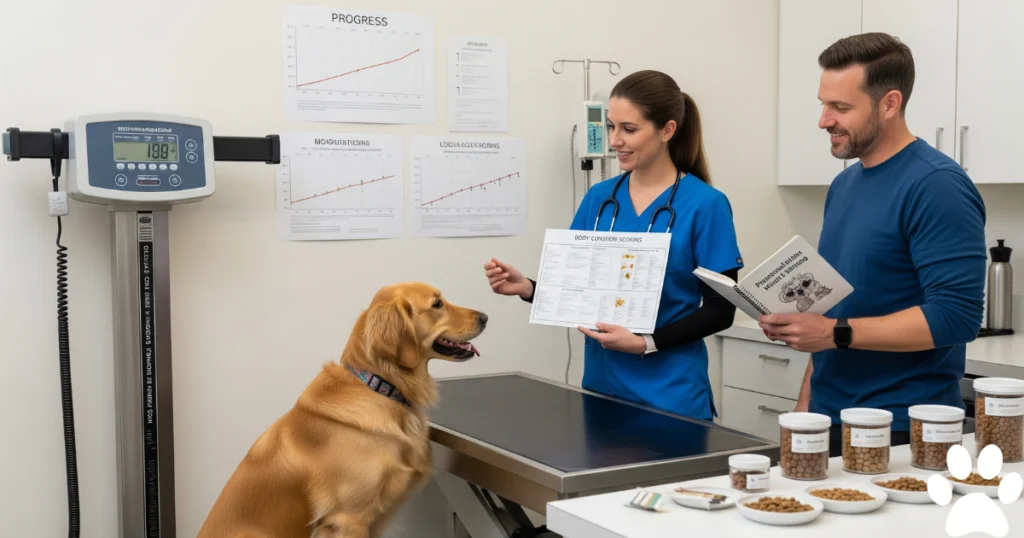
Addressing Common Challenges
Hunger Management
Initial hunger is common when transitioning to low calorie dog food, as Golden Retrievers adjust to smaller portions and different satiety signals. Increased fiber content helps, but behavioral strategies may also be necessary.
Distraction techniques can help manage hunger between meals when using low calorie dog food. Provide mental stimulation through training, puzzle toys, or interactive games that redirect attention from food seeking.
Some Golden Retrievers benefit from very small, additional meals of their low calorie dog food if hunger becomes problematic. Divide existing portions into smaller, more frequent feedings rather than increasing total daily intake.
Social Eating Pressures
Family dynamics can complicate low calorie dog food programs when other family members feel sorry for the “dieting” dog. Educate all household members about the health benefits and importance of consistency.
Establish clear rules about who can feed the Golden Retriever and when, ensuring low calorie dog food portions remain controlled. Consider using measuring containers that family members can use to provide appropriate portions.
Alternative rewards like attention, play, or small portions of low calorie dog food can replace high-calorie treats while maintaining positive family interactions during weight management.
Seasonal Adjustments
Golden Retrievers’ activity levels often change seasonally, requiring adjustments to low-calorie dog food portions or exercise routines. Winter months may require slight portion reductions if outdoor activity decreases.
Summer swimming seasons allow for slightly larger portions of low calorie dog food to support increased energy expenditure. Monitor weight closely during seasonal transitions to maintain progress.
Holiday periods present challenges for low calorie dog food consistency due to increased treat availability and disrupted routines. Plan with appropriate low-calorie alternatives and maintain regular feeding schedules.
Long-term Success with Low Calorie Dog Food
Maintenance Phase Transition
Once the target weight is achieved using low-calorie dog food, transitioning to maintenance nutrition requires careful planning to prevent weight regain. Some Golden Retrievers may need to continue with low-calorie formulations long-term.
Gradual portion increases or formula changes should be implemented slowly while monitoring weight weekly. Some dogs require only slight increases in low calorie dog food portions to maintain their new weight.
Maintenance success often depends on continuing the healthy habits established during the low calorie dog food weight loss period, including regular exercise, consistent meal times, and portion control.
Lifestyle Integration
Successful long-term use of low calorie dog food becomes part of your Golden Retriever’s lifestyle rather than a temporary diet. This perspective helps maintain consistency and prevents the yo-yo dieting common with short-term approaches.
Family education about your Golden Retriever’s ongoing low calorie dog food needs helps maintain consistency even during schedule changes or when different family members handle feeding responsibilities.
Regular reassessment of low calorie dog food needs as your Golden Retriever ages helps maintain optimal weight throughout their life stages. Senior dogs may require different approaches than younger adults.
What exactly makes dog food low calorie and safe for Golden Retrievers?
Low-calorie dog food typically contains 300-350 calories per cup compared to regular adult formulas with 400-450 calories per cup. These formulations achieve calorie reduction through increased fiber content, reduced fat levels (8-12% vs 15-18%), and strategic ingredient selection while maintaining essential nutrients. Quality low calorie dog food preserves protein levels at 25-30% to support muscle maintenance during weight loss.
How many calories should my overweight Golden Retriever consume daily with low-calorie dog food?
Overweight Golden Retrievers typically need 20-30% fewer calories than maintenance requirements when using low calorie dog food. A 70-pound Golden Retriever, normally requiring 1,500-1,700 calories daily, should consume 1,050-1,360 calories during weight loss. Always calculate based on target weight rather than current weight and consult your veterinarian for personalized recommendations.
Can I mix low calorie dog food with regular dog food?
Mixing low calorie dog food with regular formulations dilutes the caloric control and can slow weight loss progress. It’s better to transition completely to low calorie dog food over 7-10 days for optimal results. If palatability is an issue, try warming the food or adding small amounts of low-sodium broth rather than mixing with higher-calorie alternatives.
Which brands offer the most effective low calorie dog food for Golden Retrievers?
The most effective low calorie dog food brands for Golden Retrievers include Hill’s Science Diet Perfect Weight (291 cal/cup), Royal Canin Light Weight Care (306 cal/cup), Wellness CORE Reduced Fat (338 cal/cup), and Purina Pro Plan Focus Weight Management (354 cal/cup). These brands offer breed-appropriate formulations with proven weight management results.
How long does it take to see results with low calorie dog food?
Most Golden Retrievers show initial weight loss within 2-3 weeks when consistently fed low calorie dog food with proper portion control. Visible changes in body condition typically appear after 4-6 weeks, with significant results becoming apparent within 3-4 months. Safe weight loss is 1-2% of current body weight per week.
Is low calorie dog food nutritionally complete for Golden Retrievers?
Quality low calorie dog food formulations are nutritionally complete and balanced, meeting AAFCO standards for adult dogs. These formulas concentrate essential nutrients into fewer calories, often providing higher protein percentages and enhanced vitamin/mineral content compared to regular adult food. Premium low calorie dog food supports complete nutrition during weight management.
Can puppies or senior Golden Retrievers eat low calorie dog food?
Low calorie dog food is not appropriate for Golden Retriever puppies under 12 months, as they require higher calorie density for proper growth. Senior Golden Retrievers (7+ years) can safely use low calorie dog food but may need slower weight loss progression (0.5-1% weekly) and closer veterinary monitoring for age-related health conditions.
What should I do if my Golden Retriever is still hungry after eating low-calorie dog food?
Initial hunger is normal when transitioning to low-calorie dog food. Increase meal frequency by dividing daily portions into 3-4 smaller meals rather than increasing total intake. Add warm water to create more volume, use slow-feed bowls to extend meal duration, and provide mental stimulation between meals through training or puzzle toys.
How do I calculate the right portion size for low-calorie dog food?
Calculate low calorie dog food portions based on your Golden Retriever’s target weight, not current weight. Use the feeding guidelines on the package as a starting point, then adjust based on weight loss progress. Aim for 1-2% weekly weight loss – if progress is faster, slightly increase portions; if slower, reduce portions or increase exercise.
Can I give treats while feeding low calorie dog food?
Treats should comprise no more than 10% of daily calories when using low calorie dog food. Choose low-calorie options like small pieces of carrots, green beans, or specially formulated weight management treats. Many owners successfully use small portions of their dog’s low calorie dog food as training rewards to maintain caloric control.
Final Thoughts
Selecting and implementing the right low calorie dog food program for your Golden Retriever requires understanding both the science behind caloric reduction and the practical aspects of feeding management. The brands and strategies outlined in this guide provide evidence-based approaches to safe, effective weight management that maintains your dog’s health and happiness throughout the process.
Success with low calorie dog food extends far beyond simply choosing a reduced-calorie formula. It encompasses accurate portion control, consistent feeding schedules, appropriate exercise integration, and ongoing monitoring to ensure your Golden Retriever reaches and maintains their optimal weight. The commitment to these comprehensive strategies pays dividends in improved mobility, increased energy, and potentially extended lifespan.
The journey to optimal weight using low calorie dog food requires patience, consistency, and collaboration with your veterinary team. Each Golden Retriever responds differently to dietary changes, and flexibility in approach while maintaining core principles ensures the best possible outcomes. Remember that the habits established during the weight loss period with low calorie dog food form the foundation for lifelong weight management and overall health.
Your Golden Retriever’s transition to low-calorie dog food represents an investment in their long-term well-being and quality of life. The knowledge and strategies you develop during this process will serve both you and your dog well beyond the initial weight loss period, creating a framework for healthy nutrition management throughout their entire life.
Dr. Nabeel A.
Hi, I’m Dr. Nabeel Akram – a farm management professional by trade and a passionate Golden Retriever enthusiast at heart. With years of experience in animal science and livestock care, I’ve built a career around understanding animals—how they live, thrive, and bring value to our lives. This blog is a personal project born from that same passion, focusing on one of the most loyal and lovable breeds out there: the Golden Retriever. Whether I’m managing farm operations or sharing insights on canine health, behavior, and care, it all ties back to one core belief—animals deserve thoughtful, informed, and compassionate attention. Welcome to a space where professional expertise meets genuine love for dogs.
Facebook |
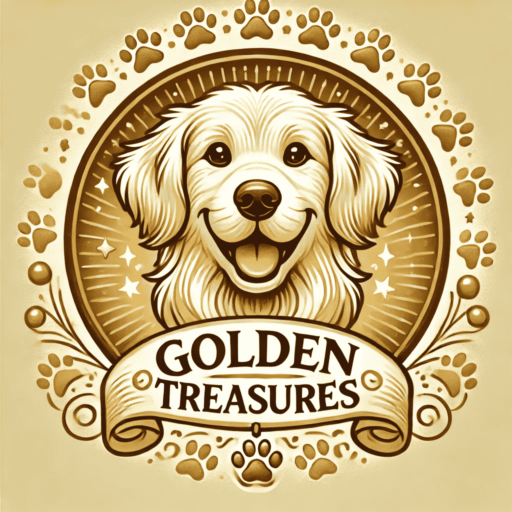
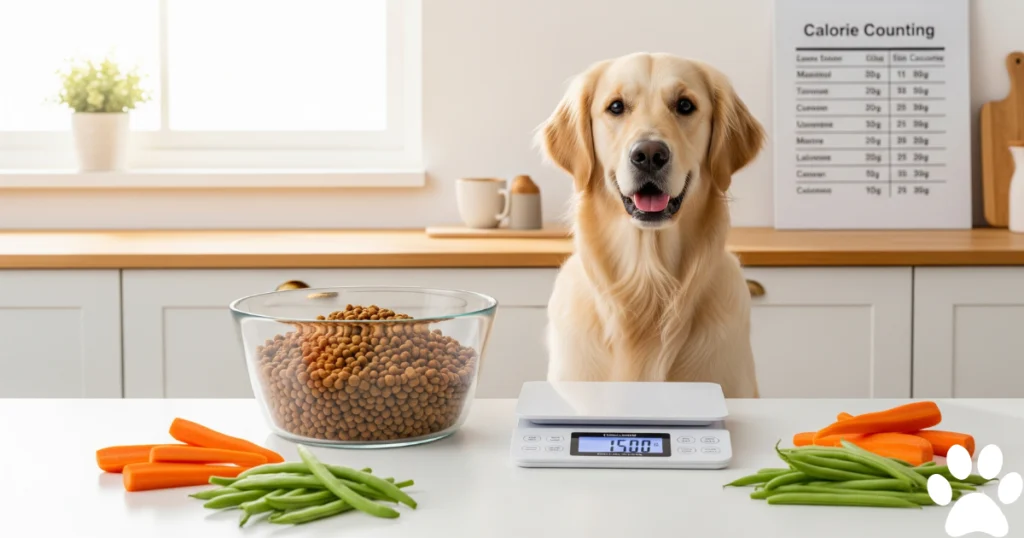
Links will be automatically removed from comments.